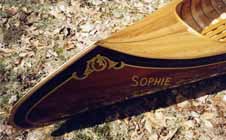Kevin Martin Wooden Boats & Canoes
Construction Techniques:
Lapstrake
The work that I do is heavily influenced by J.Henry Rushton and W.P. Stephens, both high quality small craft builders from the turn of the century. I have studied the construction methods used by both of them and have incorporated the best of each into the boats that I build in my shop.
The construction of a boat or canoe starts with a keel of red oak, which is rabbeted to receive the garboard plank. The stems can be of hackmatack root, in which the grain follows the curve needed, or they can be made of red oak that is steam bent for the curve. Planking is of dry northern white cedar or white pine. The thickness will vary depending on the type of canoe or boat the owner desires. For instance, the planks of a Wee Lassie are 3/16" thick, and up to 1/4" in other canoes. In larger craft, planks can be from 5/16" to 1/2" thick. Each plank is called a strake and each laps over the strake below it, hence the name lapstrake. The strakes are fastened through the laps with copper clinch tacks in canoes and clench nails or rivets in larger boats.
 After the canoe is planked, ribs made of ash or oak are steamed into the hull and are fastened through the planking. Gunwales, which can be ash, oak, cherry or spruce are then screwed through the ribs to strengthen the hull and tie the ends together. The decks can vary from small breasthooks in the light canoes to full two foot length cherry decks allowing dry storage for a jacket or pack. Decks can also be three or four feet long, with a cockpit to paddle or row from. These decks not only serve as protection from rough waters but also enhance the beauty of the canoe.
After the canoe is planked, ribs made of ash or oak are steamed into the hull and are fastened through the planking. Gunwales, which can be ash, oak, cherry or spruce are then screwed through the ribs to strengthen the hull and tie the ends together. The decks can vary from small breasthooks in the light canoes to full two foot length cherry decks allowing dry storage for a jacket or pack. Decks can also be three or four feet long, with a cockpit to paddle or row from. These decks not only serve as protection from rough waters but also enhance the beauty of the canoe.
The finish that I use on the bare wood of a boat or canoe is a linseed oil mixture, which is then covered with a varnish or paint. Stem bands and other necessary hardware are made of brass or bronze, with basswood floorboards as the finishing touch.
Improvements on Construction
These are a few construction methods that I have used on some models to improve my canoes. The planking at the turn of the bilge is carved from 1/2" stock to take the turn. If the garboards are too far down from the inside ribs, I place a full length shim plank of cedar or pine between the bottom plank and the ribs to prevent splitting when beaching, etc. A carlin knee is always installed at the inside edge of the longer decks, allowing for good fastening for the coaming and a handhold to use to pick up a canoe.


